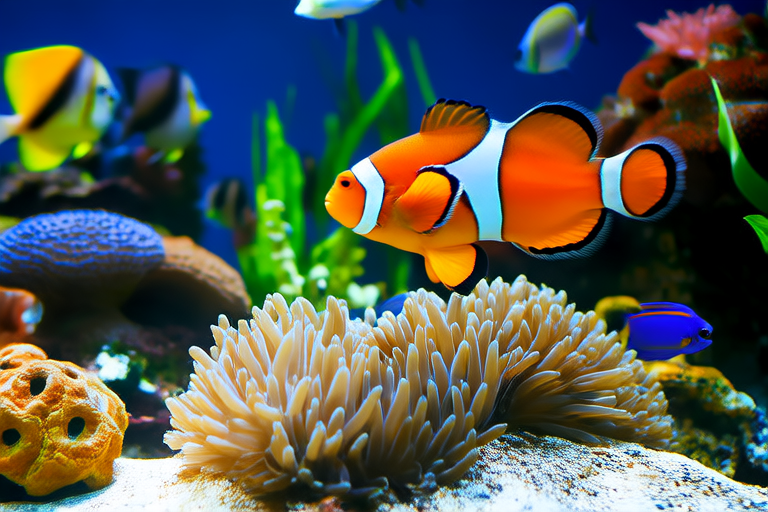From Ocean to Tank: The Ultimate Guide to Clownfish Care
Welcome to the ultimate guide to clownfish care! Whether you’re a seasoned aquarist or just starting your underwater journey, this comprehensive article will provide all the information you need to ensure your clownfish thrive in their new home. Dive into the fascinating world of these vibrant creatures and discover how to create an optimal environment for them.
Clownfish Anatomy and Behavior in the Wild
Clownfish, scientifically known as Amphiprioninae, are small, colorful fish that live in symbiosis with sea anemones. They have a distinct appearance, with their bright orange bodies, white stripes, and a black tail. Their fins are long and flowing, allowing them to navigate through the coral reefs effortlessly. In the wild, clownfish are territorial and can be quite aggressive towards other clownfish entering their territory. They are also known for their unique relationship with sea anemones, where they provide protection from predators while the anemone offers shelter.
Essential Tank Setup Requirements
Setting up the perfect tank for your clownfish is crucial for their well-being. A minimum tank size of 20 gallons is recommended, but larger tanks offer more space for swimming and exploration. Choose a tank with a good filtration system, ensuring it removes waste and maintains clean water. Adding live rock and corals not only enhances the aesthetic appeal of the tank but also provides hiding spots and improves water quality. Ensure there’s enough space for your clownfish to swim freely and explore their surroundings.
Water Parameters
Maintaining stable water conditions is vital for the health of your clownfish. Ideal temperature ranges between 76°F to 82°F, while pH levels should stay between 8.1 and 8.4. Ammonia and nitrite levels must be kept at zero, and nitrate levels should be below 20 ppm. Regular testing and maintenance of these parameters will help prevent stress and disease in your fish. Additionally, ensure proper aeration and circulation within the tank to mimic natural oceanic conditions.
Suitable Tank Mates
Choosing compatible tank mates is essential to avoid conflicts and ensure harmony within the aquarium. Clownfish generally get along well with other peaceful species like damsels, tangs, and wrasses. However, it’s important to introduce new fish gradually and monitor their interactions closely. Avoid aggressive or territorial fish that may pose a threat to your clownfish. Always research potential tank mates thoroughly before adding them to your aquarium.
Diet and Feeding
Clownfish are omnivores, meaning they eat both plant and animal matter. In the wild, they primarily feed on algae, zooplankton, and small invertebrates. In captivity, a balanced diet consisting of high-quality flake food, pellets, and occasional treats like brine shrimp or bloodworms will keep your clownfish healthy and vibrant. Feed them small amounts twice daily, ensuring they consume all the food within a few minutes. Overfeeding can lead to poor water quality and health issues, so moderation is key.
Common Health Issues
Despite proper care, clownfish can still face various health challenges. Some common issues include ich (white spot disease), fin rot, and bacterial infections. Early detection and prompt treatment are crucial for recovery. Signs of illness may include lethargy, loss of appetite, abnormal swimming patterns, or visible lesions. Regular observation and maintaining pristine water conditions can significantly reduce the risk of these problems. Consult with a veterinarian specializing in aquatic life for accurate diagnosis and treatment options.
Breeding Tips
Breeding clownfish can be a rewarding endeavor, though it requires careful planning and attention to detail. To encourage spawning, provide ample hiding spots and a dedicated breeding pair. Increase the water temperature slightly to around 84°F and ensure optimal water quality. Once the female lays eggs, carefully remove any unfertilized ones to prevent fungal growth. Keep the tank well-oxygenated and maintain a consistent temperature until the fry hatch, usually after about 7-10 days. Feed the newly hatched fry infusoria or rotifers for the first few weeks, transitioning to larger foods as they grow.
Interactive FAQs
- How often should I clean my tank?
- Regular cleaning helps maintain water quality and prevents disease. Perform partial water changes every two weeks, removing about 10-20% of the water each time. Scrub the glass and clean filters as needed.
- Can I keep multiple clownfish together?
- Yes, but it’s best to introduce them simultaneously to establish a hierarchy naturally. If you already have one clownfish, adding another may lead to aggression.
- What kind of lighting is best for my tank?
- Choose full-spectrum LED lights that mimic natural sunlight. Provide 8-10 hours of light per day to simulate day and night cycles.
- Do clownfish need a sea anemone?
- No, they don’t strictly require an anemone. While it’s beneficial for their health, many aquarium owners choose not to include one due to space constraints or difficulty in care.
- Is it possible to train clownfish?
- While clownfish aren’t trainable in the traditional sense, they can learn to associate feeding times with specific cues. Consistency in feeding routines can help them recognize when mealtime is approaching.
By following this comprehensive guide, you’ll be well-equipped to provide the best possible care for your clownfish. Remember, patience and dedication are key to creating a thriving underwater community. Enjoy the journey of nurturing these captivating creatures and watching them flourish in their new home.
